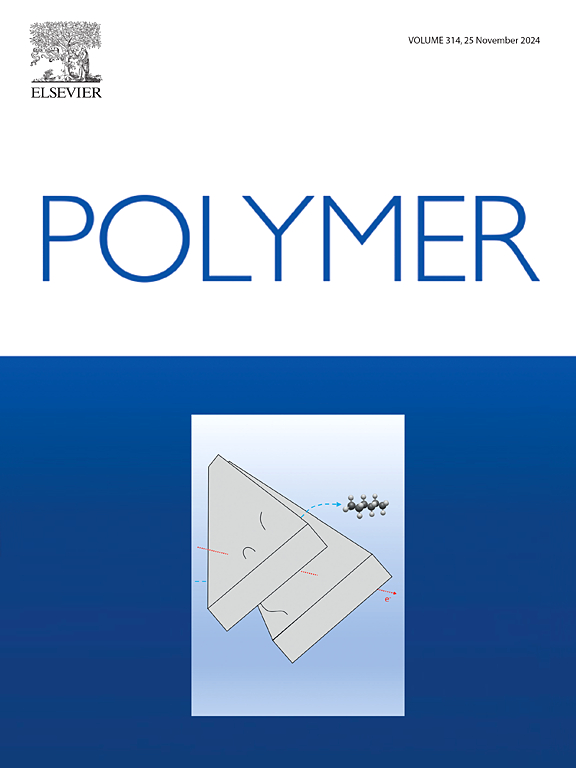Heating-induced dimensional changes in crystal lattice and lamellar thickness of isothermally crystallized poly(butylene 2,5-furandicarboxylate) (PBF)
IF 4.1
2区 化学
Q2 POLYMER SCIENCE
引用次数: 0
Abstract
Poly(butylene 2,5-furandicarboxylate) (PBF), one of the most promising biobased polyesters, was isothermally crystallized from the melt at Tc = 70, 140 and 160 °C and subsequently quenched to room temperature. For the first time, the different structural evolution of these thermally treated samples during heating was investigated in situ by synchrotron wide-angle and small-angle X-ray scattering (WAXS and SAXS) and interpreted as a function of the amorphous chain mobility at different temperatures. A structural change in the crystal lattice of the PBF crystals grown at Tc = 70 °C was detected by WAXS during heating beyond 110 °C. Coincidently, SAXS evidenced an increase in lamellar thickness during heating at temperatures close to 110 °C for all samples, regardless of their crystallization conditions. This crystal improvement could be due to the significant mobilization of the methylene sequences within the polymer chains at that limiting temperature. Thanks to less restricted and easier conformational rearrangements, the reorganization of the crystals through a melting/recrystallization mechanism could be favored. On the other hand, a different mechanism involving the rigid amorphous fraction (RAF), i.e. the constrained interphase located at the amorphous/crystal boundary, is proposed to explain the increase in the lamellar thickness observed at around 90 °C after crystallization at Tc = 70 °C. The temperature limit for the presence of the RAF in PBF was indeed identified at around 85-90 °C. Complete mobilization of the amorphous chains at temperatures above 90 °C could favor the rearrangements necessary to form thicker lamellae.

加热诱导的等温结晶聚2,5-呋喃二羧酸丁烯(PBF)晶格和层厚的尺寸变化
聚(2,5-呋喃二羧酸丁烯)(PBF)是最有前途的生物基聚酯之一,在Tc = 70、140和160℃下从熔体中等温结晶,随后淬火至室温。首次利用同步加速器广角和小角x射线散射(WAXS和SAXS)原位研究了这些热处理样品在加热过程中的不同结构演变,并解释了不同温度下非晶链迁移率的函数。在Tc = 70℃下生长的PBF晶体在加热到110℃以上时,通过WAXS检测到其晶格结构发生了变化。巧合的是,SAXS证明了在接近110°C的温度下加热时,所有样品的片层厚度都增加了,而不考虑其结晶条件。这种晶体的改进可能是由于在该极限温度下聚合物链内亚甲基序列的显著动员。由于受限制较少,构象重排更容易,因此有利于通过熔融/再结晶机制进行晶体重组。另一方面,提出了一种涉及刚性非晶部分(RAF)的不同机制,即位于非晶/晶边界的约束界面,来解释在Tc = 70°C结晶后在90°C左右观察到的片层厚度增加。在PBF中存在RAF的温度极限确实在85-90°C左右。在高于90°C的温度下,非晶链的完全动员有利于形成更厚的片层所必需的重排。
本文章由计算机程序翻译,如有差异,请以英文原文为准。
求助全文
约1分钟内获得全文
求助全文
来源期刊

Polymer
化学-高分子科学
CiteScore
7.90
自引率
8.70%
发文量
959
审稿时长
32 days
期刊介绍:
Polymer is an interdisciplinary journal dedicated to publishing innovative and significant advances in Polymer Physics, Chemistry and Technology. We welcome submissions on polymer hybrids, nanocomposites, characterisation and self-assembly. Polymer also publishes work on the technological application of polymers in energy and optoelectronics.
The main scope is covered but not limited to the following core areas:
Polymer Materials
Nanocomposites and hybrid nanomaterials
Polymer blends, films, fibres, networks and porous materials
Physical Characterization
Characterisation, modelling and simulation* of molecular and materials properties in bulk, solution, and thin films
Polymer Engineering
Advanced multiscale processing methods
Polymer Synthesis, Modification and Self-assembly
Including designer polymer architectures, mechanisms and kinetics, and supramolecular polymerization
Technological Applications
Polymers for energy generation and storage
Polymer membranes for separation technology
Polymers for opto- and microelectronics.
 求助内容:
求助内容: 应助结果提醒方式:
应助结果提醒方式:


